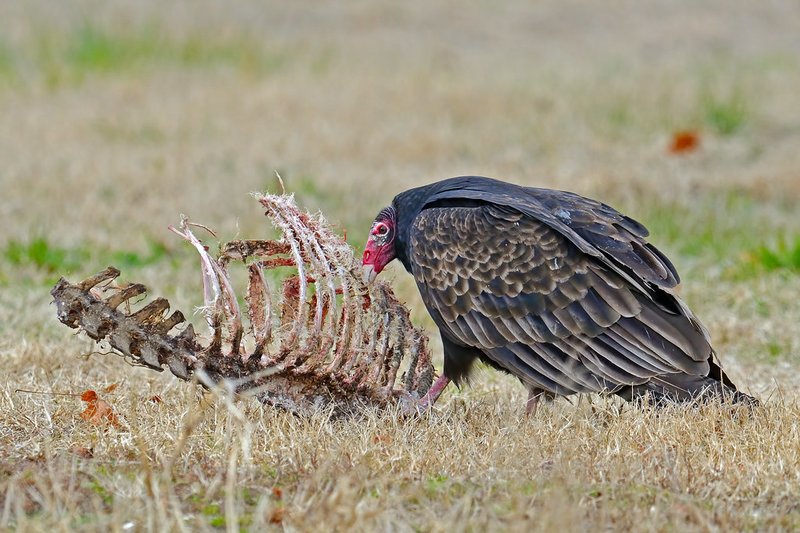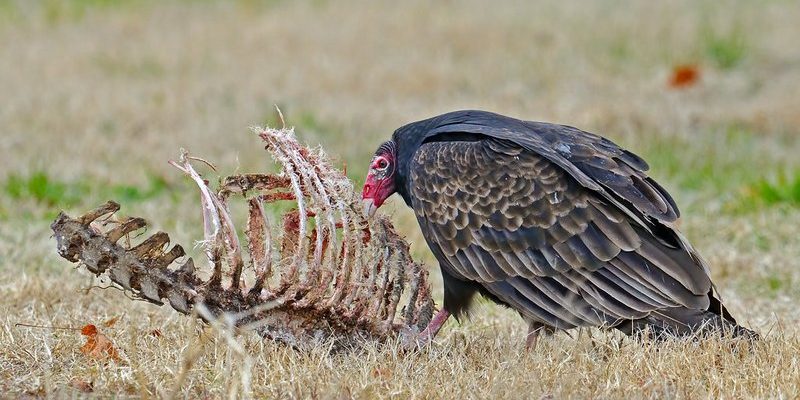
Imagine sitting outside on a warm day, watching the sky. Suddenly, you spot a turkey vulture gliding effortlessly above. Its wings spread wide, it seems to be on a mission. Unlike other birds of prey that hunt live animals, the turkey vulture has a different strategy: it specializes in finding food that’s already dead. This makes their diet unique and vital for keeping the environment clean. Let’s explore how these remarkable birds manage their meals and what they enjoy for dinner.
What Do Turkey Vultures Eat?
Turkey vultures are primarily scavengers, which means they feast on carrion—dead animals. But their diet isn’t limited to just any decomposing creature. They have a preference for larger animals, such as deer, livestock, and roadkill. It’s interesting to note that they can consume spoiled meat that would be harmful to other creatures. Their strong stomach acids help them break down harmful bacteria and toxins, making them nature’s clean-up crew.
You might be wondering how turkey vultures find this food. They rely heavily on their keen sense of smell, which is quite unusual for birds. Most raptors depend on eyesight, but turkey vultures can sniff out decaying flesh from miles away. This ability allows them to locate hidden carcasses in various environments, from forests to open fields.
One fascinating aspect of their diet is the variety of food they consume. While they mainly feast on mammals, they won’t shy away from birds, reptiles, or even fish if the opportunity arises. This adaptability ensures they can survive in different habitats, whether it’s a rural area or an urban environment.
Hunting Techniques of Turkey Vultures
You might be surprised to learn that turkey vultures don’t actually hunt in the traditional sense. Instead, they *forage* for food, which means they search for already dead animals. When they spot something promising, they circle overhead, often alongside other scavengers like eagles or other vultures. Their ability to soar for long distances without flapping their wings helps them cover large areas as they look for meals.
Once they find a carcass, they use their strong beaks to tear into it. It’s a bit like unwrapping a present, except their “gift” comes with a strong odor! Turkey vultures have a remarkable sense of teamwork as well. When one vulture finds food, others may join; this communal approach often leads to feasting frenzy, with several birds enjoying the meal together.
Interestingly, their foraging behavior is influenced by social cues too. If they see other scavengers gathering around a carcass, they’ll swoop in to investigate. This social strategy ensures they don’t miss out on a good meal when one presents itself.
How Turkey Vultures Forage
Foraging isn’t just about finding a meal; it involves getting creative and resourceful. Turkey vultures often search for food using a combination of smell and sight. They can identify areas where animal deaths are more common, such as near farms or highways.
When they glide over these locations, they look for signs like the gathering of other scavengers or the presence of decay. If you ever see a group of vultures circling, it’s a good sign that there’s something worth checking out down below. Honestly, they make scavenging look effortless!
Another vital part of their foraging is their ability to adapt to their surroundings. Turkey vultures are highly opportunistic and can adjust their foraging habits based on the season and available food sources. In winter, when food is scarce, they might venture further from home in search of a meal. This flexibility is key to their survival and contributes to their resilience in various habitats.
The Role of Turkey Vultures in the Ecosystem
Turkey vultures do more than just fill their bellies—they play a crucial role in maintaining the health of ecosystems. By consuming dead animals, they help prevent the spread of disease. You can think of them as nature’s sanitation workers, cleaning up the environment and recycling nutrients back into the soil.
Their scavenging habits also help balance animal populations. When they eat roadkill or carcasses, they reduce the risk of disease outbreaks that can occur when dead animals are left to decay unchecked. This function is vital for healthy ecosystems, where every species has its place and purpose.
Additionally, their presence indicates a healthy environment. A thriving population of turkey vultures usually means there are abundant food sources and a stable ecosystem. They are like the canary in the coal mine—when they flourish, it’s a sign that nature is doing well.
Common Misconceptions About Turkey Vultures
You might have heard some myths surrounding turkey vultures, and it’s time to set the record straight. One common misconception is that they are dangerous or aggressive. Actually, turkey vultures are quite shy and prefer to avoid confrontation. They’re more likely to flee than fight, which makes them less threatening to humans and pets.
Another myth states that they are dirty birds. In reality, turkey vultures are meticulous about cleanliness. They will often bathe in water or dust to keep their feathers clean and free of parasites. Their preening behaviors help maintain their health and streamline their hunting and foraging activities.
Also, some people think they’re a sign of death and bad luck. Instead, they’re nature’s recyclers, contributing positively to the environment. Their role is essential, and seeing them can indicate a thriving ecosystem rather than portending doom.
Habitat and Distribution of Turkey Vultures
Turkey vultures can be found across a wide range of habitats in North America. From forests and grasslands to deserts and urban areas, they’re quite adaptable. They prefer open spaces where they can soar and spot potential food sources from above.
You’ll often see them near farms, highways, and other human-altered landscapes. They thrive in areas where roadkill is more common and where farms provide a food source. Their adaptability has allowed them to spread widely, and you’ll find them from Canada to the northern regions of South America.
The turkey vulture is migratory, meaning they move between their breeding and wintering grounds, following food availability and seasonal changes. Whether soaring over fields or cruising down by the coast, these birds have a knack for finding the best places to suit their needs, proving that they’re more than just scavengers—they’re expert foragers too.
Turkey vultures are truly remarkable creatures. By understanding what they eat and how they hunt or forage, we gain a deeper appreciation for their role in the ecosystem. They serve as nature’s cleanup crew, ensuring that dead animals don’t linger and spread disease. With their keen senses and adaptable habits, they’ve carved out a niche that keeps our environment healthier.
Next time you spot one soaring high above, remember that this bird is doing important work. Whether they’re hunting for a meal or just enjoying the breeze, turkey vultures deserve our respect and admiration. They might not be the most glamorous of birds, but their unique lifestyle and contributions are vital to keeping our world balanced. So, let’s give a nod of gratitude to these fantastic scavengers!

